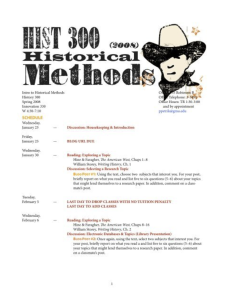Remembering Paula Petrik

Today we share the sad news that Professor Paula Petrik, our former colleague here at RRCHNM, has passed away at the age of 74 at her home in Montana.
Paula was an early pioneer in digital history and was the author or co-author of several books and/or CD-ROMs in Western history, women’s history, and digital history. As a faculty member in the Department of History and Art History here at GMU, Paula taught a number of very popular courses and was the original instructor for the second course in our digital history sequence for PhD students.

That course, which we affectionately called CLIO II, focused on web design and how historians can use the techniques of web design to communicate their research to a wide public audience. Paula was a demanding instructor, but anyone who took CLIO II came away from the experience with an acute appreciation for good (and bad) design and they were all better historians for the experience. Paula’s own syllabi were masterpieces of design. In fact, it’s probably fair to say that they were the most artful of any history syllabus our faculty has produced.
She was also a powerful advocate for undergraduate research here at Mason and in the early days of our now award-winning OSCAR program, Paula was one of the faculty members who went out of her way to mentor undergraduates as they found their feet as researchers.
My own personal connection with Paula pre-dates my time at Mason. In the fall of 2000, I was teaching at Texas Tech University and was the only person in my department remotely interested in what the Internet might mean for historians. Trying to break down some of my isolation, I invited Paula and one other historian to sign on to a panel proposal I’d cooked up for the 2001 AHA conference. Because digital history was still very new in 2001, we were very gratified when the AHA program committee accepted our proposal.
Shortly after hearing from the AHA, I saw a job posting from George Mason University’s Center for History and New Media. They were looking for a full professor of digital history to join the team here. I reached out to Roy Rosenzweig, who I’d never met, and asked him if we could chat. Because he was Roy, he wrote back immediately and we set up a call. He explained that because I was not that far along in my career, I basically had no shot at the job, but that the department was about to advertise a second job in European history that he thought I’d be perfect for. So, I applied to that one instead of the job at CHNM and was asked to interview at the conference.
Our AHA panel went quite well. Both Paula and I had to skip out afterward because we had other commitments. That was in the days when departments interviewed candidates in hotel rooms and a few hours after our panel I was loitering in the hall outside the Mason interview suite when the door opened and who should walk out but Paula! She looked as surprised as I did, then in her very Paula way, chuckled and wished me good luck. Both of our interviews went well and in August 2001 we joined the faculty here at Mason.
She called me the day after our interviews to tell me that at the conclusion of her interview, the search committee (which was doing double duty on the two searches) asked her if there was anyone else doing digital history that she thought they should be looking at. She said, “You need to interview Mills Kelly.” The committee members got frozen looks on their faces, which made her wonder if she’d said something wrong. Then she saw me in the hall and understood why they had looked that way.
Throughout my pre-tenure years here at Mason, Paula was unfailingly supportive of my career and always generous with her time and expertise. She helped me grow as a scholar more than anyone except, possibly, Roy and our then department chair Jack Censer.
As with any life that someone lived to the fullest, there is so much more to say about Paula than can fit in this space – her life growing up on a ranch in Montana, the time she was appointed chair of the math department at the University of Maine, her disagreements with Santa, and her deep love for her husband who I only ever knew by a variety of her nicknames for him.
Paula Petrik was my friend and my colleague. I’ll miss her and the world is diminished by her passing.
– Mills Kelly
